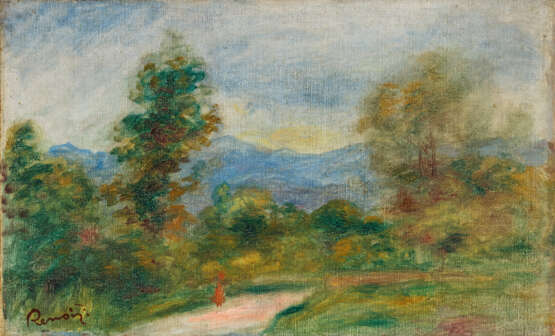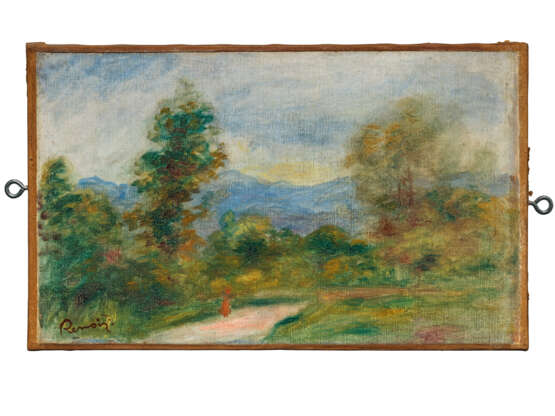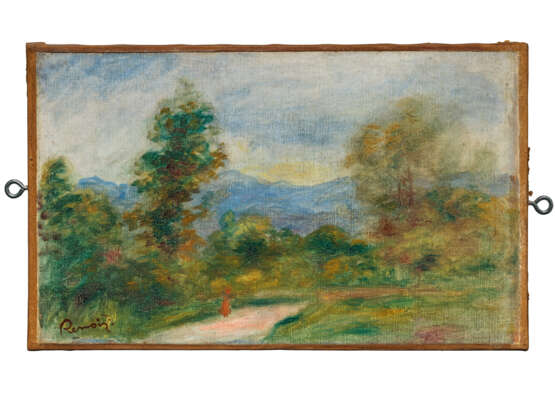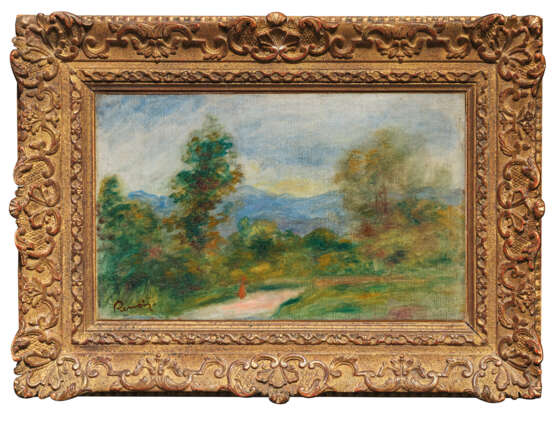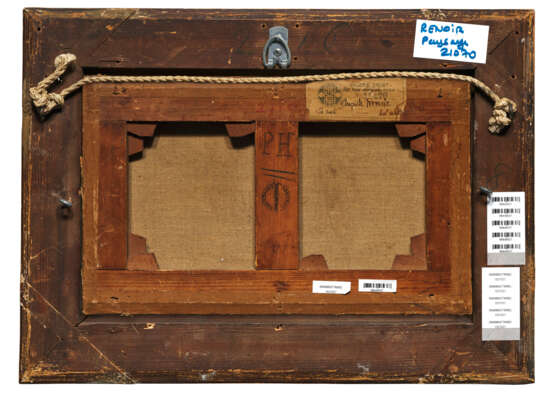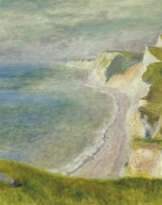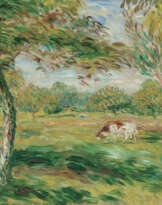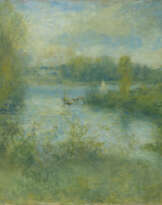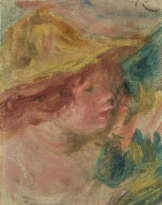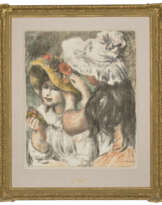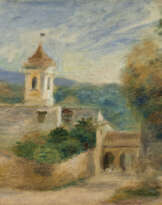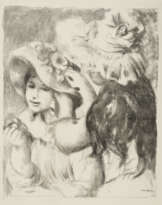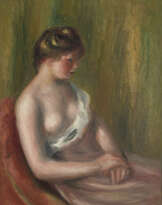ID 832388
Lot 187 | Pierre-Auguste Renoir (1841-1919)
Estimate value
€ 200 000 – 300 000
Paysage, la route
avec le cachet 'Renoir.' (en bas à gauche; Lugt 2137b)
huile sur toile
20 x 32.8 cm.
Peint vers 1885-98
stamped 'Renoir.' (lower left; Lugt 2137b)
oil on canvas
7 7/8 x 13 in.
Painted circa 1885-98
Provenance
Atelier de l'artiste.
Collection particulière, France (par descendance).
Galerie Barbazanges, Paris (acquis auprès de celle-ci vers 1922-26).
Vente, Me Bellier, Paris, 12 juin 1926, lot 86.
Collection Druet, Paris (acquis au cours de cette vente).
Galerie Eugène Druet, Paris.
Collection particulière, Paris.
Jean Patou, Paris (avant 1936).
Jean de Mouy, Suisse (par descendance).
Collection particulière, Suisse (par descendance).
Collection particulière, Suisse (acquis auprès de celle-ci).
Galerie Retelet, Monaco.
Acquis auprès de celle-ci par le propriétaire actuel en 2021.
Literature
Bernheim-Jeune, éd., L'Atelier de Renoir, Paris, 1931, vol. I, p. 234, no. 221 (illustré, pl. 71; titré 'Paysage et roses'; daté '1900').
G.-P. et M. Dauberville, Renoir, Catalogue raisonné des tableaux, pastels, dessins et aquarelles, 1911-1919 & Ier supplément, Paris, 2014, vol. V, p. 511, no. 04459 (illustré; titré 'La Route'; daté '1885').
Post Lot Text
Peinte en 1898, Paysage donne à voir la maîtrise avec laquelle Renoir parvient à réconcilier peinture en plein air et tradition artistique dans les œuvres, informelles et enlevées, qu'il réalise en extérieur dans les années 1890. La présente œuvre témoigne de l'un des aspects fondamentaux de l'impressionnisme : le principe de la peinture en plein air, qui convie l'artiste à s'installer au cœur de la nature et à brosser ses sensations sur le vif. D'un geste enlevé, Renoir varie ici sa touche pour saisir les innombrables détails du spectacle qui s'offre à lui, adaptant ses coups de pinceaux aux différentes zones du paysage. D'épaisses taches de vert et de jaune, rehaussées d'un peu de rose et de rouge pâles, viennent modeler les feuilles des arbres. Comme Claude Monet à Giverny, Renoir a converti les terres sauvages autour de sa maison en atelier à ciel ouvert ; un lieu où, malgré sa santé chancelante, il ne cessera d'observer de près la nature dont il couche inlassablement sur la toile les jeux de lumière et les couleurs diaprées. Au cœur de cette oliveraie aux reflets argentés, Renoir peint depuis une cabane où il a fait installer de grandes fenêtres qui laissent entrer la brise du Midi. « Le paysage était un microcosme où se concentrait toute la richesse du monde », écrit Jean, le fils de l'artiste, à propos de ce décor. « 'C'est grisant' ne cessait de répéter [Renoir] » (J. Renoir, Renoir, My Father, New York, 1958, p. 428-429).
Malgré l'attention minutieuse qu'ils portent à la végétation, ces paysages audacieux que l'artiste conçoit frôlent, en termes de style et d'exécution, une forme d'abstraction pleine de sensualité. En quelques coups de pinceau et en orchestrant une harmonie délicate entre les tons froids et les tons chauds, Renoir donne corps au terroir idyllique de la Provence et nous invite à ressentir l'atmosphère et les parfums de son jardin. » (cité in Renoir au XXe siècle, cat. exp., Grand Palais, Paris, 2009, p. 381).
Painted in 1898, Paysage demonstrates Renoir's successful reconciliation of plein-air painting and artistic tradition in the landscapes and informal outdoor scenes that he executed during the 1890s. The present work bears witness to one of the central tenets of Impressionism: the plein-air master standing outdoors, before nature, rapidly transcribing his immediate sensations. Renoir has employed several different types of brushwork to capture the myriad details of the natural world, differentiating the various zones of the landscape through his nimble touch. Thickly applied yellow and green daubs, heightened with a few touches of light pink and red, capture the young leaves of the trees. Just like Claude Monet at Giverny, Renoir would transform the wild surroundings of his home into an outdoor studio, where he could persistently and closely study nature, capturing its kaleidoscopic colours and light effects in his work, even despite his deteriorating health. Amid the silvery gleam of huge, ancient olive trees, Renoir worked in a specially designed shed with large windows that could be opened wide to catch passing breezes. “The landscape was a microcosm of all the riches of the world,” described Jean, the artist’s son, about this setting. “’It’s intoxicating,’ [Renoir] kept repeating” (J. Renoir, Renoir, My Father, New York, 1958, p. 428-429).
Despite the attention given to nature, these experimental landscapes typical of Renoir, in terms of execution and style, they border a form of abstract art loaded with sensuality. Indeed, with a few strokes of paint and a carefully orchestrated balance of blues and greens with reds and yellows, Renoir managed to capture the vivid presence of an southern idyllic landscape and to convey the atmosphere, the warmth and the smell of his Mediterranean garden." (quoted in Renoir au XX siècle, exh. cat., Grand Palais, Paris, 2009, p. 381).
| Artist: | Pierre-Auguste Renoir (1841 - 1919) |
|---|---|
| Applied technique: | Oil on canvas |
| Auction house category: | Paintings |
| Artist: | Pierre-Auguste Renoir (1841 - 1919) |
|---|---|
| Applied technique: | Oil on canvas |
| Auction house category: | Paintings |
| Address of auction |
CHRISTIE'S 9 Avenue Matignon 75008 Paris France | ||||||||||||||
|---|---|---|---|---|---|---|---|---|---|---|---|---|---|---|---|
| Preview |
| ||||||||||||||
| Phone | +33 (0)1 40 76 85 85 | ||||||||||||||
| Fax | +33 (0)1 40 76 85 86 | ||||||||||||||
| Conditions of purchase | Conditions of purchase | ||||||||||||||
| Shipping |
Postal service Courier service pickup by yourself | ||||||||||||||
| Payment methods |
Wire Transfer | ||||||||||||||
| Business hours | Business hours
|
